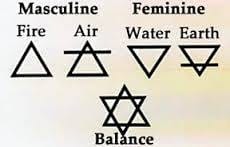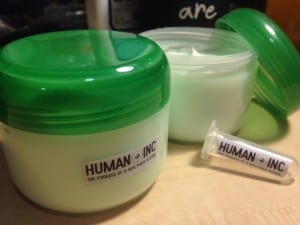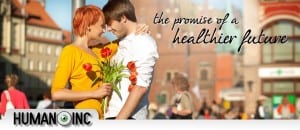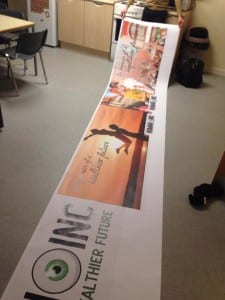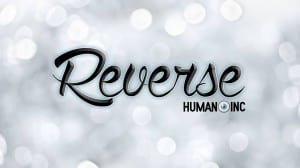On the 10th of May, 2014, Human.Inc conducted its first official market research session in the public café area of Zing. The company has always strived for perfection from day one of its conception, and the only way it would be able to reach this was through direct interaction with their customers, refining and perfecting their brand new product – ‘Reverse’. The company invited the general public into their space from 12pm until 8pm to answer a few questions based on ‘Reverse’ with the promise that they would receive a small sample of another product called ‘Bliss’. Human.Inc would then be able to use the information collected to find out where they are going right or wrong to improve their product.
Of course, due to the fact this was a site specific performance; the company was made of fiction. However the science behind the products was entirely real and the performers were still performing as themselves. The performance itself was set out to convince unsuspecting members of the public we were a legitimate company and also question ethics behind the idea of how easy it would be to change yourself for something better. The audience would be greeted into an initially familiar territory before being slowly introduced to themes and ideas that followed a more science fiction feeling. It was left to the audience to decide how long they wished to stay but the actual market research section was to last around 10 minutes with inclusion of a video introduction.
Human.Inc was created out of the idea of shops and science, two usually unlikely partners. The University had been asked to produce a set of site specific performances for the Gravity Fields Festival; “A festival creatively exploring the physical sciences and celebrating one of the world’s greatest thinkers, Sir Isaac Newton.” (South Kesteven District Council, 2014) It was this inspiration of science that is used to influence all parts of the festival, and this is what was commissioned of us by Jeremy James in the outlining letter he sent to us. “The current second year students will create four ‘mini-laboratory’ site themed performance environments” (James, 2014). He also gave us the topics of “1) Light / Optics / Electricity, 2) Weather / Astronomy, 3) Newtonian Science / Medical, 4) Alchemy.” (James, 2014) to work with and from these suggestions our group chose the idea of Alchemy.
Human.Inc therefore found itself being created from the two headings; shopping and alchemy. When we were first introduced to the site specific module we were told that our site performance areas were ‘unoccupied shops in Grantham town centre’ and that we were given the working title of ‘Retail Therapy’. It was then left to ourselves to figure out what we did with the spaces, and how we could incorporate both shopping and alchemy into them.
Retail therapy is an odd yet charming concept. The idea that one can go through a simple bad day, heartbreak, or bad news and fix it with a new pair of shoes that you can’t really afford but it’s okay because “I deserve it!” is an odd one to me, yet it constantly keeps me completely fascinated. Material goods in replacement for emotion? Ridiculous. But imagine if shops sold actual emotions? I don’t mean you pay some little old lady to tell you an uplifting anecdote from her past to liven your mood. I mean somewhere between the drug dealers in the season 3 episode of Doctor Who, ‘Gridlock’ (Doctor Who, 2007) and the famous ‘Drink Me’ potions of Alice in Wonderland (Geronimi, 1951). Shelves upon shelves of ‘Happy’, ‘Sad’, ‘Love’, ‘Anger’ and so on. Would it be the cure for all humankind or the beginning of its decline? We already have the monstrosity of date rape drugs; imagine getting drugged with ‘love’. You could even slip a bit of ‘generous’ to your mean boss who won’t give you that pay-rise. In a time where the phrase ‘retail therapy’ is thrown around between varying levels of need, how far would people be willing to go to feel just that little bit happier?
Site Specific performance can take many different styles; it is not dictated to just follow one style of performance. For example, you can have a performance like ‘Seedbed’ by Vito Acconci in 1972 which featured “Acconci beneath a ramp built in the Sonnabend Gallery. Over the course of three weeks, he masturbated eight hours a day while murmuring things like, “You’re pushing your cunt down on my mouth”” (Saltz, 1972) Whereas on the other hand you could have a performance like Gob Squad’s 2003 performance of ‘Super Night Shot’ in which they show a film that has been recorded “exactly one hour before you come to watch it when the four performer/activists meet, arm themselves with their video cameras and start them simultaneously.” (Gob Squad, 2003). Although these performances are both thought to be site specific, Andy Field wrote “All of these fascinatingly diverse and brilliant shows are subsumed under the suffocating umbrella of “site-specific”. A piece of shorthand that crudely shackles together artists whose work couldn’t be more different” (Field, 2008) which questions whether the broad sense of ‘site-specific’ is right, and perhaps the concept has become too widely used. It became our concern to make sure we used the empty shops as part of our performance.
Through a number of discussions we had come up with two very different performances that would work for the brief given to us, the first of which being solely based on Alchemy. Although alchemy never really achieved what it set out to do, which was the creation of the philosophers stone, the ability to change base metals into gold, and to create the elixir of life, it did explore many other possibilities.
When I was younger, my school used to take us on many science museum trips, and one of the most memorable (probably because it was so terrible) was Magna. Magna was a “Science Adventure Centre packed with interactive exhibits and fascinating displays to help you explore the wonders of science and the laws of nature, with over one hundred hands-on exhibits designed to help you explore the four elements – AIR, WATER, EARTH and FIRE!” (Magna, 2014). Even though admittedly this place was truly terrible, the aesthetics of the rooms and the 4 elements fascinated me. These themes influenced our first idea. Using ideas found in the classical scriptures of alchemy, we thought to create a performance of physical theatre inspired by the four elements. Using epic orchestral music (such as this one) we could create a multimedia performance viewed through the window of our store. Moving our bodies in time with the music as projections are blasted around and onto our bodies we physically become the elements, until a climactic finish where we end and with our four separate symbols of air, water, earth and fire coming together thus creating the alchemic pentagram that is made up of the symbols for each (as seen in the image below). The only problem with this idea is that it only encompasses the idea of alchemy and ignores the idea of shops.
The second idea we had was of a make believe corporation that works to make humans better. This idea combined the idea of shopping and alchemy (in the sense that they were hoping to find a product that could take something not perfect and turn it perfect). To get ourselves into the mood of a big corporation, we introduced the idea in the form of a formal email;
Dear Customer,
Thank you for taking an interest in our products and treatments. It is always pleasing to hear such enthusiasm about our company, and always helps us to strive for greatness. In regards to your request for a brief description of our goals and “Mission Statement”, this is what we have managed to put together for you.
Human.Inc is the beginning of a new era, a new dawn and a new life. Everyone has their problems, everyone has their worries, and everyone feels like they aren’t perfect. This is where we come in. Human.Inc is a movement created to make your insecurities our main priority. With a host of the leading scientists and dermatologists working every day to create perfection, we are happy to bring these bounding leaps in technology forward for human consumption. Combining your DNA, muscles, skin and anatomy with our patented Human.Inc bio-mechanics, we are able to take you one step above human, to perfection. We are also working towards creating fully functioning human counterparts to provide help and company for those that need it, though it must be remembered; that kind of technology still has a while left to go. For now, enjoy our range of ultra-safe products and mechanics soon to be hitting your stores within the next few months.
We hope this brief description will help you to understand us in more detail.
Thank you very much,
Hope El-Roi. Founder of Human.Inc
There’s that famous saying; “When life gives you lemons, make lemonade” coined by Elbert Hubbard in the original phrasing of “He picked up the lemons that Fate had sent him and started a lemonade-stand” (1915). The phrase is used to describe a situation where something seemingly goes wrong, but you make the best of what you have been given. We were told that our original site area, Grantham, was no longer available for us to perform in on the 10th of May and we were to make use of the LPAC to perform our performances. Determined not to lose all meaning of this project, our group wanted to gain a space that was more than just an empty studio with 4 black walls. We started looking into emailing the local council in the hope we’d be able to use one of the empty shops on Lincoln high street, but it was soon suggested we attempt to gain the Zing cafe in the Lincoln Performing Arts Centre.
After a short exchange of emails we were granted access to the area at the end of the space (shown below). The space comes ready set with varying things I felt will actually make our performance more interesting than if we used the empty space in Grantham.
The Zing cafe area has;
– A TV we can play some form of information or promotional video on
– Sofas and other furniture we can make use of if we see fit.
– A notice board we can put posters on
– A Book shelf
– Leaflet rack we can put information booklets in.
After spending time in this space getting used to this area, we have come to the decision that this performance area will possibly be more beneficial to us than the empty shop in Grantham, as we are using a ‘non-theatre location’ (Wilkie, 2002) which just so happens to still be in use as a space that works in the retail industry on a daily basis.
It was around this time that Human.inc finally started becoming real. Actual things were made to convince our audience we are real. Over the Easter holiday Sarah Broadbent and I worked furiously hard to create everything physical for the performance. We had completed our market research questionnaire and had made a start on creating and printing some of the products’ labels and posters we are using in the space. However, some of the creation of these materials proved harder than others… I’ll start with the positives.
We were told that creating some form of small token the audience can take home is the right thing to do, as not only will it draw in audience, it will also make our company more believable. But what were we to put into these small tubes? Water is the only safe thing we can give our audience for fear of allergies in case anyone actually drinks it. One of the original ideas we had was ‘Emotions in a bottle’, so it was decided that we should give away a small vial of ‘Happy’, but what was the science behind the possibility? Short of selling an illegal drug, we looked into the science of endorphins, but found that artificial creation seemed impossible. However, we did find a product by the company Pondera Pharmaceuticals called Endorphinate which sells itself with the description; “Imagine finally being able to naturally experience the sense of calm, comfort, and well-being that leads to joy and happiness in life.” (Pondera, 2014). Knowing this kind of thing is on the market and available shows that creating a liquid version was more possible.
Now for the negatives that happened… printing big. The only way we will have a professional looking space is with professional looking posters. I spent a few days looking at various Pharmaceutical websites. I came across the company VRTX who, on their website (https://www.vrtx.com/), had classy pictures that changed near the top of their page featuring people looking very happy with the company’s slogan as part of the image. This was the inspiration I used for Human.Inc’s images, with our slogan ‘A Promise of a Healthier Future’.
We decided to use the pull plotter in the library as you can print large images at a small price. Our first attempt was perfect quality, only it printed half the image. On the second attempt, we used a different printer and although it came out the right size, the image quality is dreadful and it pixelated the whole image. We then did the same settings on the original printer but it came out pixelated again. In the end we managed to get the images printed at the quality they needed to be, however the hassle was unbelievable.
When it came to one week until the performance day I started questioning myself. Did I feel ready? Of course I didn’t. I felt like all we had was still just ideas and nothing concrete. We had everything sorted. I’d spent many nights making the videos and posters and leaflets, and the group as a whole had worked hard finding the information and science, all we needed was the audience. The only problem I was having was wrapping my head around the idea that it was a performance. We have been told that for site performance we still have to play ourselves, yet I didn’t see Jake Allsop, the 20 year old drama student, being the chief executive of Human.Inc. Mike Pearson wrote some exercises related to site, in which he asked questions such as “What would you have remembered had you gone there without a camera?” and “Write a text of 50 words describing one location you particularly remember” (Pearson, 2010). These kinds of exercises are solely looking at the idea of site, whereas due to the fact we’ve been taken out of our site, and we’re not doing something based on the shop we saw, I felt the performance for the audience would be too jarring and they may be left questioning what the point was. It all feels too safe. We’re mimicking what a real life company would do; it didn’t feel like Site Specific performance, it felt like a business simulation.
When the actual performance came around, it went well. Suited and booted we dressed our space into the style we wanted it to be and spent the day inviting what turned out to be around 50 audience members to take part. Due to the style of performance we gave, every member of the audience experienced something different, some people were left in the waiting area for longer than others and were able to experience the aesthetics for longer. We invited people at the end to leave emails in case they wanted more information about our product ‘Silk’. It was at that point we asked for feedback.
“I was sucked into a world in which companies like yours actually exist” (Brook, 2014), “I feel as though you were all very professional and sold the product well without making me buy anything upfront!” (Ford, 2014) “The design of your products are very sophisticated” (Ochi, 2014). These were the kind of remarks we received from people who came to the performance. Due to the fact our survey was hosted on a website called Zoho, we were able to process the results into online statistics
We found that 72% of participants were aged 20-29, meaning that we would have to conduct the session again in a space with a more varied selection of public. However, we have gathered that most people buy health products from shops like Boots or Superdrug, people would appreciate a smooth texture and a fruity scent, and the maximum price range they would pay for a pot of reverse would be around £41-£50.
Because we are performing the piece again in Grantham in September, we have the lucky advantage of being able to change anything we felt needed improving. It was decided that apart from a few minor aesthetic changes, and an odd grammar mistake, the only major thing that may need changing is implementing a sense of danger. This aspect was something we lost during development. The introduction of something sinister behind the company would make it more interesting for an audience member, and maybe more meaningful once they leave.
I think throughout the module, I have learned about how diverse site specific performance can be. This is described by Andy Field when he wrote “the term is now used to describe almost every show that isn’t put on in a purpose-built auditorium. That’s missing the point” (2008) I find I agree a lot with what he’s saying. As interesting as the idea of site-specific performance can be, it’s been turned into something that it shouldn’t be, it’s become too broad, and I’d like to see it come back to where it belongs. Performances directly based on where they are set; the history, its surroundings, and the feeling.
WORKS CITED
Brook, L. (2014) RE: Human.Inc Silk Product Information [email] Sent to Jack Tullin, 10 May.
Doctor Who (2007) [DVD] Series 3, Episode 3. London: BBC.
Field, A. (2008) ‘Site-specific theatre’? Please be more specific. [online] The Guardian, Available from http://www.theguardian.com/stage/theatreblog/2008/feb/06/sitespecifictheatrepleasebe [Accessed 12th May 2014]
Geronimi, C. (dir.) (1951) Alice In Wonderland. [film] United States: Walt Disney.
Gob Squad (2003) Super Night Shot [online] Nottingham. Available from http://www.gobsquad.com/projects/super-night-shot [Accessed 11th May 2014]
Hubbard, Elbert (February 1915), “The Fra: A Journal of Affirmation”, The Fra (Elbert Hubbard) 14 (5): xxiv–d, archived from the original on September 13, 2012
James, Jeremy (2014) Gravity Fields Festival 2014 Collaboration with University of Lincoln Students [letter] Sent to the University of Lincoln.
Joseph, N. (2014). a basic idea for retail therapy. [Blog] Retail Therapy. Available at: https://sitespecific2014dsy.blogs.lincoln.ac.uk/2014/01/27/a-basic-idea-for-retail-therapy/ [Accessed 11 May. 2014].
Magna (2014) Magna – Science Centre [online] Rotherham. Available from http://www.visitmagna.co.uk/science/ [Accessed 11th May 2014]
Ochi, K. (2014) RE: Human.Inc Silk Product Information [email] Sent to Jack Tullin, 10 May.
Pearson, M. (2010) Site-Specific Performance. Houndmills: Palgrave Macmillan.
Pondera Pharmaceuticals (2014) Why Endorphanite? [online] Available from http://ponderapharma.com/why-endorphinate/ [Accessed 27 April 2014]
Saltz, J. (1972) Seedbed [online] New York. Available from http://www.virtual-circuit.org/art_cinema/Acconci/Acconci/Seedbed.html [accessed 11th May 2014]
South Kesteven District Council (2014) Gravity Fields Festival 2014 Homepage. [online] Grantham. Available from http://www.gravityfields.co.uk/ [Accessed 5th May 2014]
Tullin, J (2014) Retail Therapy. [blog] Lincoln: University of Lincoln. Available from https://sitespecific2014dsy.blogs.lincoln.ac.uk/ [Accessed 15 May 2014]
Wilkie, F. (2002) Mapping the Terrain: a Survey of Site-specific Performance in Britain’, New Theatre Quarterly, 18, 2, 140-60.

